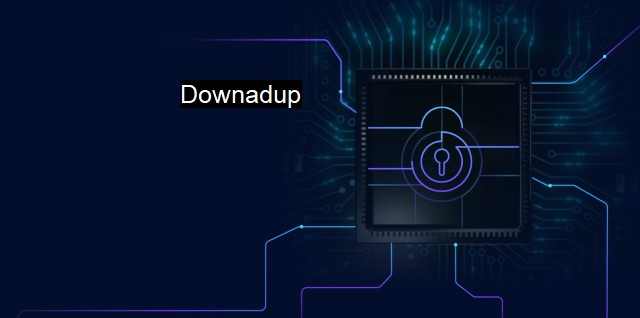What is Downadup?
Guarding Against the Global Threat: Understanding the Downadup/Conficker Computer Worm and Its Deadly Impact on Windows Systems
Downadup, also known as Conficker or Kido, is a computer worm that is known for its significant influence on various means of cybersecurity. The worm attacks the microsoft Windows operating system by exploiting areas where security is weak or absent. The main target of Downadup includes all versions of Windows since Windows 2000.The first detection of Downadup was in November 2008, having been discovered by several firms specializing in antivirus software. Interestingly, Downadup is different from traditional worms as it employs a multitude of advanced malware techniques. For instance, it utilizes its in-built dictionary to carry out brute force vulnerabilities stuffing attempts on admin passwords. It further utilizes a complex peer-to-peer communication protocol to initiate communication among different worm nodes, making it more challenging to mitigate.
One of Downadup's distinct traits is its capability to disable certain system services. These services are typically involved in the automatic downloads or updates of system patches, which are installments aimed at fixing security vulnerabilities. By disabling these protective systems, Downadup makes the system even more susceptible to other attacks and to cooperative manipulation processes. Servers that are used to update protective software can also be attacked, which means the worm not only features distinct capabilities, but also enables other programs to undermine the overall system security.
Downadup also employed a unique method to propagate through the utilization of a domain generation algorithm (DGA). This malware software used to generate around 500 unique domain names each passing day. The worm then tried accessing these domains as a part of its command and control (C&C) infrastructure to receive updates and further instructions.
Formidable in its design and execution, Downadup caused an influx of cybersecurity concerns worldwide. It is estimated that at its peak, the Downadup worm infected approximately 15 million computers globally. Not discriminating between personal and corporate systems, the worm had infiltrated and caused disruptions across a wide scale - incapacitating many businesses and public institutions on an international level.
Solving the Downadup situation wasn't an easy task either. Antivirus software developments needed a proportionate consideration of the substantial and effective techniques that the worm used. Other exigencies revolved around commendable collective efforts from various experts in the industry engaging in groups, sharing vital insights, and devising wide range measures to counteract this groundbreaking cyber threat.
Remedies for Downadup involved different procedures. Internet Systems Consortium was applied to register domains that the worm could potentially contact. This way, the propagation was significantly halted as a preventive measure. Aggressively patching all system software helped to fix the vulnerability exploited by Downadup. But perhaps the most effective remedy was using and updating antivirus software that could not only detect, but also remove Downadup from infected systems.
By default, Downadup has had a notable impact on the cybersecurity environment. It echoed the need for stronger defensive measures to withstand fast-evolving modern-day threats. The worm unveiled the importance of periodic system updates, aggressive patching of software, and a comprehensive, up-to-date antivirus solution for shielding networks and computers from similar threats.
In its aftermath, Downadup highlights an invaluable lesson; assurance of cybersecurity doesn't merely revolve around the development and the integration of high-tech, robust systems. Instead, it equally involves a keen eye on managing and addressing the vulnerabilities presented. Today, Downadup serves as a prime example in cybersecurity narratives, of the threats that technology evolution continues to present and antivirus experts' relentless determination to counter them.

Downadup FAQs
What is Downadup?
Downadup, also known as Conficker, is a type of computer worm that can spread through local networks and the internet. It originally surfaced in 2008 and has since been updated several times with new variants. Downadup is known for its ability to evade detection and spread rapidly.How does Downadup infect computers?
Downadup primarily spreads through network shares and by exploiting vulnerabilities in the Windows operating system. It can also spread through removable drives and by downloading malicious files from the internet. Once a computer is infected, Downadup can disable important security features and download additional malware.How can I tell if my computer is infected with Downadup?
Some signs that your computer may be infected with Downadup include a slow or unresponsive system, disabled security features, and unusual network traffic. However, Downadup is known for its ability to hide its presence, so it's possible to have an infected computer without any obvious symptoms. It's important to perform regular antivirus scans and updates to prevent infection.How can I protect myself from Downadup?
To protect yourself from Downadup, it's important to keep your operating system and antivirus software up to date. You should also avoid downloading files from untrusted sources and be cautious when opening email attachments. Additionally, you can disable the Autorun feature on your computer to prevent Downadup from spreading through removable drives. Regular backups of your important files can also help you recover from an attack.| | A | | | B | | | C | | | D | | | E | | | F | | | G | | | H | | | I | | | J | | | K | | | L | | | M | |
| | N | | | O | | | P | | | Q | | | R | | | S | | | T | | | U | | | V | | | W | | | X | | | Y | | | Z | |
| | 1 | | | 2 | | | 3 | | | 4 | | | 7 | | | 8 | | |||||||